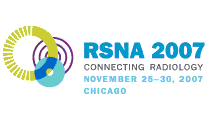
Abstract Archives of the RSNA, 2007
SST04-05
Detecting Acute Rejection in Renal Allografts by Ultrasound Elastography: A Feasibility Study
Scientific Papers
Presented on November 30, 2007
Presented as part of SST04: Genitourinary (Ultrasound)
Unmin Bae PhD, Abstract Co-Author: Nothing to Disclose
Orpheus Kolokythas MD, Presenter: Consultant, Koninklijke Philips Electronics NV
Investigator, Koninklijke Philips Electronics NV
Research grant, Koninklijke Philips Electronics NV
Sanaz Behnia MD, Abstract Co-Author: Nothing to Disclose
Raimund Pichler, Abstract Co-Author: Nothing to Disclose
Nicolae Leca MD, Abstract Co-Author: Nothing to Disclose
Manjiri Kiran Dighe MD, Abstract Co-Author: Nothing to Disclose
Carlos Cuevas MD, Abstract Co-Author: Nothing to Disclose
Theodore J. Dubinsky MD, Abstract Co-Author: Nothing to Disclose
Yongmin Kim PhD, Abstract Co-Author: Nothing to Disclose
et al, Abstract Co-Author: Nothing to Disclose
et al, Abstract Co-Author: Nothing to Disclose
To evaluate the feasibility of detecting acute rejection in renal allografts by ultrasound elastography.
The study was approved by our institutional review board, and informed consent was obtained from subjects. 25 patients who were scheduled for renal allograft biopsy (14 males and 11 females with age range from 21 to 80 years) participated in this study. Prior to the biopsy, an ultrasound exam was performed where external freehand compression was applied on the surface of the abdomen and baseband ultrasound data were acquired for off-line analysis. We computed two metrics, RSI and RSVI, and correlated them with diagnosis from the biopsy.
RSI (renal stiffness index) = mean strain of cortex & medulla / average strain of elastogram.
RSVI (renal stiffness variation index) = standard deviation of strain in cortex & medulla / average strain of elastogram.
Renal allografts were classified into two groups: acute rejection (n=9) and others (n=16). The latter group included allografts with glomerulosclerosis (n=3) and acute tubular necrosis (n=2). RSVI of the acute rejection group (0.65±0.05) was smaller than that for the other group (0.80±0.15), indicating that there is less stiffness variation in the cortex and medulla of the allografts with acute rejection (p<0.01). Using a cutoff RSVI value of 0.7, the sensitivity for detecting acute rejection was 78% while the specificity was 88%. On the other hand, RSIs from the two groups were not significantly different. Furthermore, there was no statistically significant difference between the acute rejection group and the other group in both serum creatinine and the resistive index from Doppler ultrasound.
Measuring variation of the stiffness in the cortex and medulla of renal allografts may be useful for diagnosis of acute rejection. Ultrasound elastography may detect acute rejection even when it is not evident by changes in serum creatinine and resistive index. Further study is needed to evaluate the efficacy of ultrasound elastography in differentiating acute rejection from other causes of allograft dysfunction.
Ultrasound elastography could be a noninvasive tool for detecting acute rejection in renal allografts.
Bae, U,
Kolokythas, O,
Behnia, S,
Pichler, R,
Leca, N,
Dighe, M,
Cuevas, C,
Dubinsky, T,
Kim, Y,
et al, ,
et al, ,
Detecting Acute Rejection in Renal Allografts by Ultrasound Elastography: A Feasibility Study. Radiological Society of North America 2007 Scientific Assembly and Annual Meeting, November 25 - November 30, 2007 ,Chicago IL.
http://archive.rsna.org/2007/5014194.html

